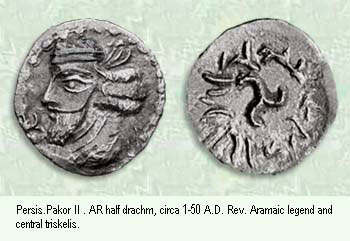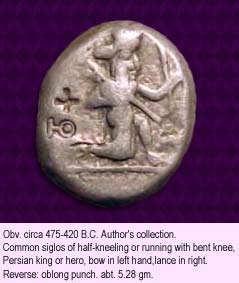|
|
Page I |
|
|
 |
|
|
|
|
|
|
|
|
Preamble |
|
|
|
Text
guide |
|
|
|
|
|
|
|
|
|
|
|
|
|
|
|
|
|
|
|
|
|
|
|
|
|
|
|
| |
|
|
Whether ankle-winged, armour-legged, medusa-centred,
tripteral or ibis-beaked, the triskelis wheels itself up and down
the hills of history until the present day *1.
Coins bearing this symbol were issued early, in the 7th
century B.C. Enigma shadows its significance and symbolic
references shifted as man's fertile imagination
beckoned and brewed. An unwavering constant however persists, the
three or perhaps four national symbols adopted by : ancient
Lycia, possibly the Kingdom of Olba,
definitely today's Sicily, and
the Isle of Man. All chose
the triskelis. Why?
The present exposé does not and cannot suggest absolute origins
or reasons defining the triskelis but at- tempts to provide time-links
between nations brandishing the symbol, a few or more regional samplings,
and varying forms. We also hope to share a few ideas and ponderings
with the reader concerning significances behind this elusive symbol.
It would be interesting to learn how the symbol was referred to
by the Ancients and the meanings invested
thereto. Have they remained silent or would any visitor know ? |
|
|
 |
|
|
|
|
|
|
|
|
|
|
|
|
|
|
|
|
|
|
|
|
|
|
|
|
|
|
| |
Possible triskelis symbol
meanings :
astronomy
battle
competition
speed
strength / might
independence
valour
victory
|
|
|
|
|
|
|
|
|
|
|
|
|
|
|
|
|
|
|
Citius,
Altius, Fortius |
|
|
|
|
|
part 1 - Mesopotamia
and Asia Minor |
|
|
|
|
|
|
|
|
|
|
|
|
|
|
|
Could the triskelis
have sprinted forth from some indistinct, yet uncovered past ? There
exists no proof although we hope through Nippur “The Holy”,
archaeologists shall produce one pointing towards Sumer’s iconography.
Since cuneiform times (3000 / 3500 B.C.)
Sumer’s influence pursued
oncoming successive powers including the Sassanians whom we find below
.[
65 ]
Sumerian thought emerged as the spiritual backbone guiding an expanding
Mesopotamia. Religious beliefs of this primeval culture were not singly
adopted by contemporaries but later modified to form a foundation
for Babylonians and oncoming successors dominating the region. Predating
written Assyrian and Babylonian, Sumer’s non-Semitic isolate
language, dominated future literary works. Sumerians also founded
case laws towards governing society. Parallels aligning Sumerian beliefs
against Judeo-Christian-Islamic religious traditions prompt serious
study today. Researchers uncovered a Sumerian tablet written as late
as the first century B.C. Delving back
“the sand-glass” observes triskeles cut into Assyrian
signets. (Assyrian empire : ca. 1363 –
609 B.C.). |
|
|
|
|
|
|
|
|
|
|
|
|
Chronological dating
of Persis coins and kings remains unclear due to varying interpretations.
It seems the political importance awakening Persis takes definition
within the 8th century B.C. Later, Cyrus
the Great leads Persis as king in 559 B.C.
Foremost descriptions of Persis ascertain the region’s independence.
The land remained free of Seleucids (approximately 290
B.C.) until Mithradates II regained control, attaching it to
Parthia until Artaxerxes defeated him and established the Sassanide
empire. This territory lies north of the Persian gulf in today’s
Iran whence we glimpse a passing triskelis. Weather known or unknown
the kings of Persis place a triskelis in evidence once we chance upon
them through time’s latticed shadows. [ 1 ] [
2 ] [ 46
] |
|
|
|
|
|
|
|
|
|
|
|
| |
|
|
Extending
Sumerian and Babylonian culture, the Sassanians surprise us at Naqsh-I-Rajab.
We meet a court dignitary donning a triskelis upon his mitre. The
event is the investiture of Shapur I, Sassanian monarch, 239
to 270-272 B.C. This revealing image is made available here
by courtesy of the Oriental Institute of the University of Chicago
[ 3 ].
Observing this photograph closely, the mitre next to the triskelis
offers a circular symbol, stemmed and pedestaled. This sphere also
forms countermarks upon Achaemenid silver siglos [
51 ]. Other sigloi bear the same withinside reverse incuse
punch marks *18.
Site part one shows a triskelis countermarking another Persian specie,
circa 450-330. Naqsh-I Rajab, believed
to be a sacred site, predates the Achaemenids.
(site part one : www.roth37.it/COINS/Triskeles/index.html. monetazione-Impero
Persiano) |
|
|
 |
|
|
|
|
|
|
|
|
|
|
|
|
|
|
|
|
|
Spanning A.D.
224 to 633 the Sassanian dynasty emerged from the Persis capital
(Istakhr or Stakhr). Both civilizations culturally depended upon Sumer,
nevertheless Greek influences remain a sharp contester supporting
the noted presence of this particular triskelis. Other theories exist
pending precise identity of these “Court Dignitaries” (shown
above, number 3) who may have been high priests, temple astronomers
or even military elite. Their mitre symbols perhaps represented a
sun, moon, or other astrological bodies. These alongside diverse geometric
designs resemble Central Asian tamghas with which Sassanian elite
were known to have adorned headwear and horse caparisons (See Soghdiana
here). However long ahead, Sassanians, Babylonians and Assyrians designed
triskelis seals, some on record with Chicago’s Oriental Institute
. |
|
|
|
|
|
|
|
|
|
|
|
|
|
|
|
|







